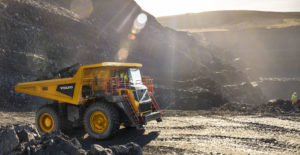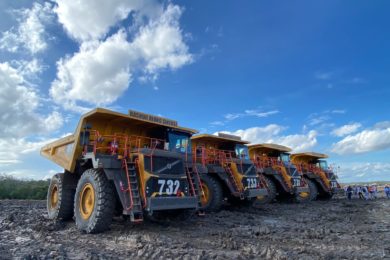Volvo’s rigid haulers have come a long way and are starting to prove their performance in terms of uptime, efficiency and longevity. Back in April 2018, Volvo CE launched the R100E mining truck at its Motherwell factory in Scotland – a completely new 95 t (100 ton) class rigid hauler. It combined the best of both world’s; a wealth of market and customer knowledge with proven components that came from Terex Trucks that Volvo had acquired in 2014, along with new technologies and a striking new design developed under Volvo’s ownership. Since 2018, the truck has proven itself in challenging locations worldwide – initially mainly in Europe, Russia and Central Asia, then South Africa and more recently in the Americas. For regulated markets it has been fitted with a premium 783 kW Stage V/Tier 4 Final engine, for a drivetrain that provides high torque capabilities, unparalleled pulling functionality and class-leading rim pull for optimum performance. So what has been happening? Paul Moore, IM Editorial Director, spoke to Vice President of Volvo CE Rigid Haulers, Paul Douglas, in some depth about product development, customer feedback and long term R&D.
Vice President of Volvo CE Rigid Haulers, Paul Douglas

Q Can you outline the R100E market response since 2018 in terms of rollout?
With the launch followed by the pandemic, it has been quite a rollercoaster four years. But the truck has found its way and a firm place in the market. Starting with the first version available, the low regulated Tier 2 engine version is really performing and delivering ease of maintenance with our mining clients. A key area for us is Indonesia, working with our dealer PT Indotruck Utama, it has become a top performing market – it has a vast rigid truck market for this size class – and we have had units there since 2019. These initial units were on trial up against the Komatsu HD785 and Sany SRT95. The trucks performed very well and numbers have increased since then, most recently in the form of four units sold to contractor PT Hasnur Riung Sinergi, two of which are lighter weight versions where we have been able to add 4 t to the payload bringing it to 99 t. Interestingly, Indonesia is also a big user of our rigid R60D 60 ton truck. In Africa, we have sold some units in South Africa via Babcock, as well as in Zambia, but the ADT is very strong in Africa, and of course we are active there as a supplier with products from Volvo and Rokbak. We have two focus markets on the African continent – sub-Saharan Africa with Babcock but also North and West Africa via SMT. They have had success with the R60D in Nigeria, for example. Lastly on North America, we sold the first Tier 4 Final engine equipped R100E trucks for a customer in Texas, not for mining but for hauling steel scrap from dock stockpiles into a steel mill. Five trucks went there with special large bodies equipped with tailgates. The project was a great success and they are still running with over 7,000 hours in less than two years. The dealer there has been very engaged with both our Volvo team and with the customer and the maintenance system is very well established. This project has got the R100E noticed in North America and we are having advanced discussions with several other customers. Finally in Latin America, where Terex Trucks were not that well known, we have shipped five R100Es to a minesite in Chile; with the customer already looking at another five. Last but not least in the European market, we have had units in Sweden, Finland and Norway – in Norway in particular we have been able to grow a significant market share with the R100E and R70D, initially Tier 2 under the approved scheme but ultimately the customers there will use models with Stage V engines. Again, the Volvo-owned dealer there is very close to the customer. The mine and quarry operators in Norway are very focussed on emissions and ESG – there is significant demand there, and throughout Europe, for the R60 with Stage V engines when these become available in 2023. Beyond Scandinavia we have also shipped units to Poland and Austria as an example. Worldwide, demand for rigid trucks is huge at the minute, but supply is limited and lead times are long due to the global logistical problems we are still seeing.
Q In the markets where you have units running, what has the feedback been like?
We have had some great feedback, especially where the dealers have good knowledge of the rigid hauler and mining applications. These dealers have invested a lot of resource as well as ensuring they have a good spare parts inventory, the right tools, plus trained technicians – all close to the customer. The R100E offers uptime comparable or superior to any other truck in its class. Some of our larger dealers have additionally kept some of our rigids as part of their rental fleets. Looking at Indonesia, using a lighter design means the R100E has a maximum payload of 99 t. That’s a full 4 t more than the regular version with its 95 t payload. The capacity of the body for the lighter version is increased too, from 60.4 m3, with the regular version to 65 m3 for the lighter version. This capability is greater than any competitor offering in the 100-ton class, enabling customers to increase profitability on top of the obvious productivity gains. The R100E V-shaped body is designed for optimum load retention and minimal material carry-back, while the body-tipping system ensures efficient dumping. The On-Board Weighing option is an integrated system that ensures the machine moves the optimum safe payload to further optimise production and minimise operational costs. The hauler also has impressive tractive effort meaning no terrain is too deep or steep. An engine overspeed protection feature automatically slows down the machine to within safe operating limits if the driver goes too fast. In addition, a neutral coast inhibitor and transmission retarder are included as standard to protect the hauler in downhill operations. Fail-safe braking and secondary steering systems provide extra security. Overall, there is a major difference between the performance of the old Terex Trucks TR100 and the Volvo CE R100E.
Volvo CE says the R100E offers uptime comparable or superior to any other truck in its class

Q Can you talk about the product evolution timeline for the sub-100 ton models?
The R60D in particular remains one of our most in demand models so after the R100 that has been our main focus, albeit interrupted by the pandemic. The next generation of the 60 ton I can say is well on its way and is set to be launched soon. Currently, we have a few pilot units running with a customer in the UK. Like the R100E, this is a completely redesigned model from the ground up. As before we will launch a version for unregulated markets first, followed by a Stage V engine version for regulated markets. But the time gap between the two this time will be much shorter, partly reflecting the fact that unregulated countries are catching up in terms of emissions requirements. The new R70 will come soon after that.
Q Why produce both a 60 ton and a 70 ton machine, do they both have distinct market niches?
That is a good question as they do overlap in terms of markets, and they do share a lot of components. The 70 ton is a very good and stable truck size – and the largest truck you will get in most quarries, with the exception of some superquarries of which in the UK for example there are only a handful. Therefore, our R70 and predecessor TR70 have had a really good and solid footprint in hard rock quarrying operations. While the 60 ton rigid is also widely used in quarrying, it is also seeing a lot of demand in mining for coal haulage, infrastructure work etc – and in certain markets, like Indonesia and Brazil, it competes well with the increasingly large number of so called “wide body” trucks coming out of China – but often these trucks, as well as Chinese rigids in this class, do not have the same sales and service support over time as we would have. Back to the truck sizes – in the market a lot also depends on the primary crusher or hopper dump capacity in the operation, which can dictate the truck size that can be used.
Q Finally, aside from the next generation 60 and 70 ton rigids; can you comment on work being done by Volvo CE in areas like electric drive inclusion, or even battery electric powertrains?
Volvo Group and Volvo CE have been very open in their commitment to decarbonisation and safety operational safety in the form of automation – exemplified by development projects like the autonomous, cab-less and battery powered TA15 hauler, which comes under Volvo Autonomous Solutions and is running at several sites including a Holcim limestone quarry in Switzerland. Larger sizes of that design are being looked at. Volvo also recently started testing a hydrogen fuel cell powered ADT – the HX04 – in Sweden. Plus there is the option of hydrogen as a fuel for the combustion engine. And there is the option to have diesel engines running on HVO fuel, powering electric wheel motors on smaller trucks, which are already dominant in the larger mining trucks. As far as the Volvo rigids are concerned, it is obvious that these types of things are also on our roadmap given the 30% reduced emissions target that Volvo has set by 2030 and beyond, zero emissions by 2040. I can’t say much more but I can say that for every Volvo truck size and class there is a lot of focus on developing an autonomous and electric version – as the Volvo Climate Strategy and goals dictate that there will have to be. But there are several avenues as to how we get there, and as with other OEMs we haven’t put all our eggs in one basket just yet.










